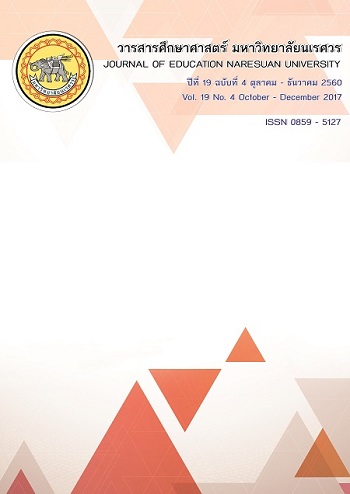การพัฒนารูปแบบการออกแบบการเรียนการสอนแบบการเรียนรู้กลับด้านตามกรอบแนวคิดทีแพคและทฤษฎีขยายความคิดสำหรับครูมัธยมศึกษา สังกัดสำนักงานคณะกรรมการส่งเสริมการศึกษาเอกชน
Main Article Content
บทคัดย่อ
งานวิจัยนี้เป็นการวิจัยและพัฒนา มีวัตถุประสงค์เพื่อพัฒนาและศึกษาผลการใช้รูปแบบการออกแบบการเรียนการสอนแบบการเรียนรู้กลับด้านตามกรอบแนวคิดทีแพคและทฤษฎีขยายความคิดสำหรับครูมัธยมศึกษา สังกัดสำนักงานคณะกรรมการส่งเสริมการศึกษาเอกชน เก็บรวบรวมข้อมูลด้วยวิธีการแบบผสมวิธี (Mixed-method) โดยมีขั้นตอนการวิจัย 4 ขั้นตอน คือ 1) ศึกษาความคิดเห็นของผู้เชี่ยวชาญและครูมัธยมศึกษา 2) พัฒนารูปแบบฯ 3) ทดลองใช้รูปแบบฯ และ 4) รับรองรูปแบบฯ ผลการพัฒนาฯ ได้รูปแบบการออกแบบการเรียนการสอนแบบการเรียนรู้กลับด้านตามกรอบแนวคิดทีแพคและทฤษฎีขยายความคิดสำหรับครูมัธยมศึกษาฯ ที่มี 8 องค์ประกอบและขั้นตอนการออกแบบการเรียนการสอน 12 ขั้นตอน ผลการทดลองใช้รูปแบบฯ พบว่า ครูกลุ่มทดลองเห็นว่ารูปแบบฯ มีความเหมาะสม นักเรียนจำนวน 315 คน ซึ่งเรียนด้วยแผนการจัดการเรียนรู้แบบกลับด้านมีความพึงพอใจอยู่ในระดับมากและผู้ทรงคุณวุฒิให้การประเมินรับรองรูปแบบฯ อยู่ในระดับดีมาก
Article Details
เจ้าของบทความมิได้คัดลอก หรือละเมิดลิขสิทธิ์ของผู้ใด หากเกิดการละเมิดลิขสิทธิ์ ไม่ว่าวิธีใด หรือการฟ้องร้องไม่ว่ากรณีใด ๆ ที่อาจเกิดขึ้นได้ กองบรรณาธิการวารสารศึกษาศาสตร์ ไม่มีส่วนเกี่ยวข้องทั้งสิ้น ให้เป็นสิทธิ์ของเจ้าของบทความที่จะดำเนินการ
References
Bergmann, J., & Sams, A. (2014). Flipped learning: Gateway to student engagement. Eugene, OR: ISTE/ASCD.
Creswell, J. W., & Clark, V. P. (2007). Designing and conducting: Mixed method research. Sage Publications.
Enfiled, J. (2013). Looking at the impact of the flipped classroom model of instruction on undergraduate multimedia students at CSUN. TechTrends, 57(6), 14-27.
Institute for the Promotion of Teaching Science and Technology. (2013). PISA 2015 results Mathematical literacy, reading literacy, and scientific literacy: executive summary. Bangkok: Advance Printing Service. (in Thai)
Jackson, R. G. (1993). The effect of elaboration theory in facilitating achievement of varied educational objectives in print/text materials (Doctoral dissertation). The Pennsylvania State University.
Kim, M. K., Kim, S. M., Khera, O., & Getman, J. (2014). The experience of three flipped classrooms in an urban university: an exploration of design principles. Internet and Higher Education, 22, 37–50.
Koraneekit, P., Songkram, N., & Khlaisang, J. (2014). Educational technology and communications: Blended learning innovation. Bangkok: Chulalongkorn University Press. (in Thai)
Li, K. H., Lou, S. J., Tseng, K. H., & Huang, H. C. (2013). A preliminary study on the Facebook-based learning platform integrated with blended learning model and flip learning for online and classroom learning. In: Wang, J. F., Lau, R. (eds) Advances in Web-Based Learning – ICWL 2013. ICWL 2013. Lecture Notes in Computer Science, vol 8167. Springer, Berlin, Heidelberg
Panich, W. (2013). Teacher for students: building a flipped classroom. Bangkok: RS Printing Mass product. (in Thai)
Phillips, C. R., & Trainor, J. E. (2014). Millennial student and the flipped classroom. ASBBS Proceedings, 21(1), 519-530.
Reigeluth, C. M., & Stein, F. S. (1983). The elaboration theory of instruction. In C. M. Reigeluth (Ed.) Instruction Design Theories and Models. Hillsdale, NJ: Lawrence Erlbaum Associates.
Reigeluth, C. M. (2012). Chapter 8: Instructional theory and technology for a postindustrial world. Trends and issues in instructional design and technology (3rd ed.). Boston, MA.: Dempsey, Pearson Education.
Richey, R. C., Klein, J. D., & Tracy, M. W. (2011). The instructional design knowledge base. New York: Taylor & Francis.
Staker, H. C., & Horn, M. B. (2012). Classifying K-12 blended learning. Retrieved March 5, 2014, from http://files.eric.ed.gov/fulltext/ED535180.pdf.
Udom, P. (2011). Active teaching and learning approaches in science (ATLAS). Journal of Education Prince of Songkla University, Pattani Campus, 22(3), 317-330. (in Thai)
Wiginton, B. L. (2013). Flipped instruction: An investigation into the effect of learning environment on student self-efficacy, learning styles, and academic achievement in an algebra I classroom (Doctoral dissertation). The University of Alabama.
Wongsuwankongpow, W. (2005). Development of an instructional model based on Reigeluth's elaboration theory for enhancing content accuracy, task expertise and transfer of learning abilities of higher education level students (Doctoral dissertation). Bangkok: Chulalongkorn University. (in Thai)
Yang H. H., & Chen P. (2010) Building teachers’ TPACK through WebQuest development and blended learning process. In: Tsang P., Cheung S.K.S., Lee V.S.K., Huang R. (eds) Hybrid Learning. ICHL 2010. Lecture Notes in Computer Science, vol 6248. Springer, Berlin, Heidelberg.

